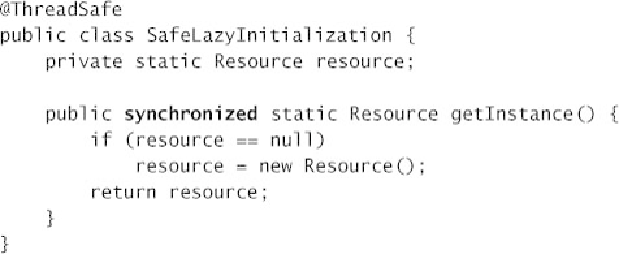Java Reference
In-Depth Information
16.2.3. Safe Initialization Idioms
It sometimes makes sense to defer initialization of objects that are expensive to initialize until
they are actually needed, but we have seen how the misuse of lazy initialization can lead to
trouble. UnsafeLazyInitialization can be fixed by making the getResource method synchron-
ized, as shown in
Listing 16.4
. Because the code path through getInstance is fairly short (a
test and a predicted branch), if getInstance is not called frequently by many threads, there is
little enough contention for the SafeLazyInitialization lock that this approach offers adequate
performance.
The treatment of static fields with initializers (or fields whose value is initialized in a static
initialization block [JPL 2.2.1 and 2.5.3]) is somewhat special and offers additional thread-
safety guarantees. Static initializers are run by the JVM at class initialization time, after class
loading but before the class is used by any thread. Because the JVM acquires a lock during
initialization [JLS 12.4.2] and this lock is acquired by each thread at least once to ensure that
the class has been loaded, memory writes made during static initialization are automatically
visible to all threads. Thus statically initialized objects require no explicit synchronization
either during construction or when being referenced. However, this applies only to the as-
constructed state—if the object is mutable, synchronization is still required by both readers
and writers to make subsequent modifications visible and to avoid data corruption.
Listing 16.4. Thread-safe Lazy Initialization.

